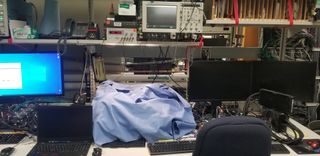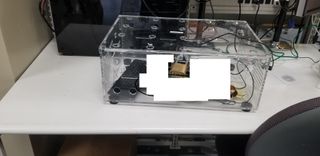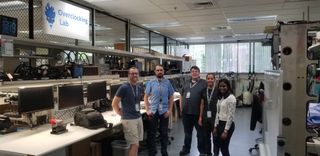Intel says it loves overclocking, but saying it and proving it are two different things entirely. We here at Tom's Hardware certainly love overclocking, so we visited Intel's Jones Farm campus in Portland, Oregon, recently for an exclusive tour to see how the company designs and architects its chips for maximum overclockability.
Intel's overclocking lab has silently steered the company's overclocking efforts for years and, understandably, the company has been hesitant to open it up to the media. To our knowledge, we are the first tech news outlet to visit and report on the facility. As we can see below, the lab is packed with next-gen gear that the company isn't ready to divulge, some of it hidden under Intel-blue lab coats for our visit.
Security is an everyday concern at Intel, and as part of its standard operating procedures, sensitive gear is kept in locked Plexiglas cases in most of the building when it isn't actively being tested. The cases are large enough to make it difficult, if not impossible, to ferret hardware out of the building unnoticed. Inside of the confines of the OC lab, which is protected by a keypad entry system, the technicians can operate with a bit more freedom.


Intel is certainly a company at a crossroads: After more than a decade of dominance, it is pressured by AMD with its Ryzen processors that offer leading performance in key metrics, and at ultra-competitive pricing that challenges Intel's desktop PC dominance.
Much of AMD's advantage lays in TSMC's 7nm process, which is denser and more efficient than Intel's go-to 14nm node. But overclocking headroom remains an advantage for Intel, as its chips have much more margin between the rated boost frequencies and overclocked clock rates than AMD's processors.
Make no mistake, AMD has done a great job of extracting the utmost performance from the new 7nm node, but the fact remains: The industry is grappling with stagnant, if not declining, clock rates from process nodes as they shrink further, leading many to question if overclocking is dead.
During our visit, we discussed the labs' role and procedures, examined the gear, asked Intel's team about the future of overclocking, and peppered them with questions about some of the important concerns on the minds of overclockers, like safe voltage guidelines and the impact of overclocking on chip longevity.
Move the Bits Faster
Overclocking is all about pushing the bits inside the processor faster by altering it to operate beyond the rated specifications. It sounds simple enough, but as enthusiasts know, what appears to be a rather straightforward exercise can be extremely complex, especially if you're pushing the extreme edge of performance.
As challenging as wringing the utmost performance out of silicon can be, it's nothing compared to the complexity of designing and integrating that functionality into products that begin their life as grains of sand. Consider this: At 5 GHz, the nanometer-scale transistors inside today's modern chips switch on and off at a rate of five billion times per second, and that isn't even the pinnacle of performance – it isn't uncommon to see speeds over 7 GHz with liquid nitrogen cooling.
Exposing that hidden performance to enthusiasts and casual users alike presents tremendous challenges for the engineering teams tasked with ensuring the billions of transistors on your chip can survive the rigors of elevated voltages and temperatures that come as a byproduct of overclocking.

That's one of the fundamental reasons why Intel created its Overclocking Lab, a team of engineers led by Dan Ragland, the Principal Engineer of Performance Tuning & Overclocking Architecture. The team is tasked with not only exposing new overclocking features to users but also tracking silicon quality, voltage scaling and conducting long-term stress testing, all of which help the company improve its processors for all users – even those that aren't interested in overclocking.
The overclocking lab operates in relative secrecy as far as the public is concerned, but it is just down the hallway (and to the right) from where we attend Intel's annual data center briefings, so it isn't necessarily hidden inside Intel's Jones Farm campus in Portland, Oregon.
For our tour, Ragland was joined by four members of his eight-person engineering team that he handpicked for their experience in multiple disciplines, from mechanical/thermal engineering to software. Ragland selects from among the best the company has to offer, but aptitude and enthusiasm are key traits he looks for when selecting team members. A passion for overclocking is a ground-floor requirement to make the team.
A group of eight engineers seems like a small number of engineers dedicated to overclocking performance for a company with a market cap of ~$250 billion, but this team interacts with multiple other groups, from Intel's Israel-based IDC team during the design phases of processor architectures to the teams responsible for power code management and overclocking software, among many others.
The team also interfaces with motherboard vendors to help them optimize their platforms for overclocking, part of which includes overclocking workshops that we'll cover shortly. Intel also regularly brings in leading overclockers from around the world to work with them in the lab to help the company better understand the challenges of overclocking, and address issues.
We asked during our tour if the lab also does competitive performance analysis of competing products, like testing AMD's chips for comparison, "We're very aware of our competition, but we can't say much beyond that," Ragland responded.
We'll dive in on the history and rationale behind Intel's overclocking initiatives on the following page, then dive in deeper on the tech behind the scenes.
MORE: Best CPUs
MORE: Intel & AMD Processor Hierarchy
MORE: All CPUs Content
"hardware" - Google News
January 02, 2020 at 02:44AM
https://ift.tt/36qOmp7
Inside Intel's Secret Overclocking Lab: The Tools and Team Pushing CPUs to New Limits - Tom's Hardware
"hardware" - Google News
https://ift.tt/34VCCtX
Shoes Man Tutorial
Pos News Update
Meme Update
Korean Entertainment News
Japan News Update
No comments:
Post a Comment